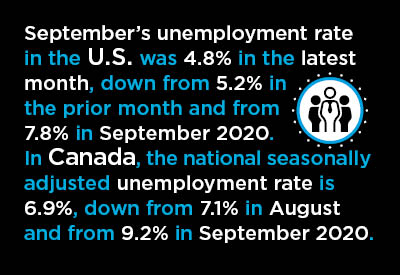There are two big stories from the September Jobs reports just released for the U.S. and Canada.

For the U.S., total employment in the latest month rose by only +194,000 jobs, a disappointing figure resulting from re-emergent coronavirus cases due to the virulence of the Delta variant. As vaccination coverage continues to widen, this negative influence will gradually dissipate, and analysts are hopeful that October will see a better jobs creation performance.
But for the U.S. construction sector, the truly eye-catching numbers from September reside in the compensation tables. According to Table B3, which includes supervisory personnel, construction worker weekly earnings were +7.2% year over year.
From Table B8, which is strictly for production workers (i.e., it excludes bosses), construction worker earnings in the latest month were +10.2% y/y. That’s a double-digit percentage increase for the first time in the data series going back to at least January 2000.
The weekly earnings gains for ‘all jobs’ in September were +4.6% year over year from Table B3 (including supervisors) and +5.8% y/y from Table B8 (excluding bosses).
As for hourly earnings, ‘all jobs’ made a compensation advance of +4.6% y/y in September to construction’s +4.5% in Table B3. In Table B8, it was +5.5% for ‘all jobs’ and +5.8% for construction.
Therefore, it was in the weekly wages designation where construction workers reaped an especially big reward. The demand for their services led to them spending more time on job sites.
There’s another related possibility. The present high number of unfilled positions, as identified in monthly JOLTS reports, may have required existing construction work crews to stay ‘in the harness’ longer.
In any event, some construction workers ended up with bulging pay packets.
The U.S. not seasonally adjusted unemployment rate (NSA) in September was 4.5%, down a smidge from August’s 4.6% and considerably better than September 2020’s 7.1%. The comparable NSA U rates for ‘all jobs’ in the latest month were 4.6% in Sept 2021, 5.3% in Aug 2021 and 7.7% in Sept 2020.
September’s headline unemployment rate, which is the seasonally adjusted (SA) figure, was 4.8% in the latest month, down from 5.2% in the prior month and a drop of 3.0 percentage points from 7.8% in September 2020.
U.S. Construction Employment +22,000 in September
U.S. construction employment in September rose by +22,000 jobs. Half of the increase (+11,000 jobs) was with nonresidential specialty trade contractors. This is a departure from recent times, when residential general and sub-trade contractors have accounted for most of the jobs gains.
The U.S. total jobs recovery ratio, versus the huge drop in employment that occurred between February and April of last year, when the arrival of COVID-19 sent most social and business activity into a deep dark funk, has now improved to 77.8%. There’s still a gap of -5.0 million jobs.
By the way, one of the drags on U.S. employment has centered in the motor vehicle and parts assembly area. The much-discussed shortage of computer chips has forced temporary shutdowns of assembly and supplier operations.
Further to the subject of a ‘chips’ shortage, Intel has just announced planned spending of $20 billion on two new production plants to be built at the company’s existing location in Maricopa County (Phoenix), Arizona. Part of the reason for the high cost will be the need for special ‘clean’ rooms to avoid contamination.
Break out the Champagne, Canada Achieves Full Jobs Recovery
What’s the special news from Statistics Canada’s September jobs report?
The total number of jobs north of the border in the latest month climbed by +157,000, with full-time endeavors ahead by +194,000 (i.e., coincidentally, the same as the U.S. total month-to-month jobs jump). Part-time Canadian jobs were -36,000.
The break-out-the-champagne news for Canada, though, was that the +194,000 was just enough to restore total employment in the country to where it was in February 2000 (19.13 million), before the jaw-dropping collapse in March and April of last year.
In other words, the jobs claw-back ratio in Canada is now 100%.
The number of Canadian manufacturing jobs in the latest month rose by +22,000. Construction employment, however, moved in the other direction, falling by -11,000.
Regionally, the lowest unemployment rates in the country are currently in Manitoba (5.6%), Quebec (5.7%) and British Columbia (5.9%).
The national seasonally adjusted unemployment rate is 6.9%, marginally down from 7.1% in August and significantly down from 9.2% in September 2020. The not seasonally adjusted unemployment rate, adopting the same calculation methodology as utilized in the U.S., is 5.2%, not far off the previously mentioned comparable figure of 4.6% for south of the border.
Alex Carrick is Chief Economist for ConstructConnect. He has delivered presentations throughout North America on the U.S., Canadian and world construction outlooks. Mr. Carrick has been with the company since 1985. Links to his numerous articles are featured on Twitter @ConstructConnx, which has 50,000 followers.
Please click on the following link to download the PDF version of this article:
Economy at a Glance Vol. 17, Issue 143 – Two Outstanding News Items from September’s U.S. and Canadian Jobs Reports – PDF










Recent Comments